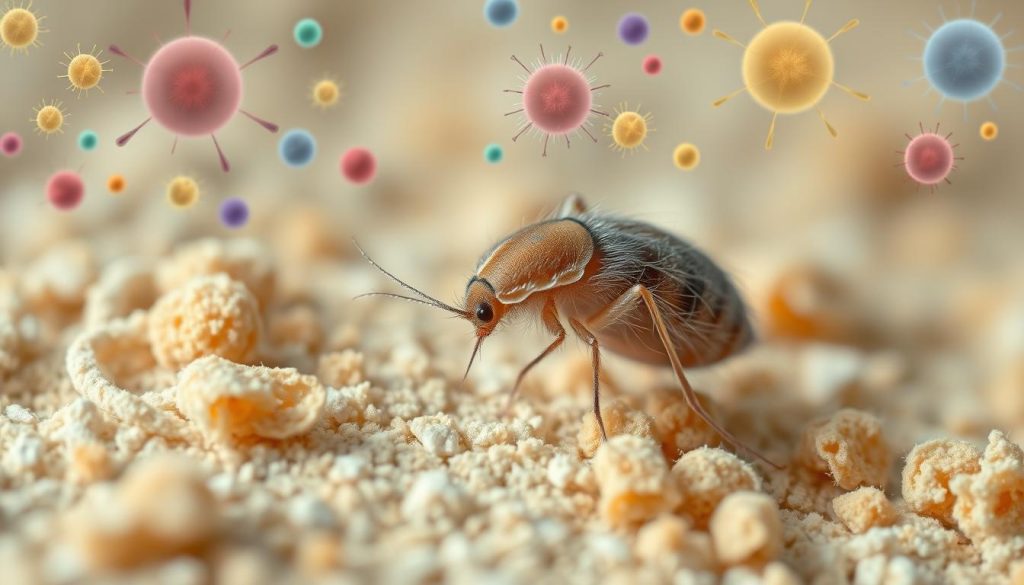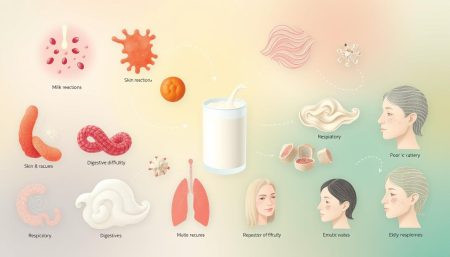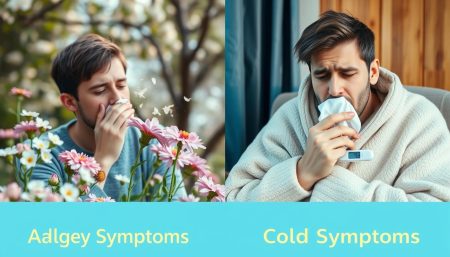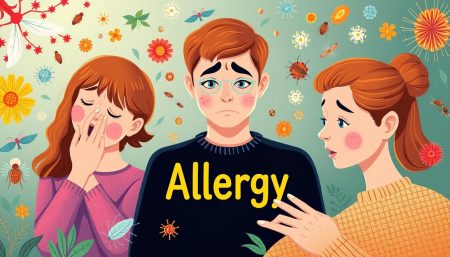Dust mites can cause a lot of discomfort and distress for many people. It’s important to understand dust mite allergies to take back control of our health. These tiny creatures live in our homes and can cause many dust mite allergy symptoms that affect our daily lives.
This article aims to help those dealing with allergies. It explains the details of dust mite allergic reactions to help you spot signs early. This way, you can manage and treat your allergies more effectively. Allergies can cause physical pain and emotional stress, so it’s crucial to talk about them.
This guide is like a beacon for those struggling with dust mite allergies. It offers valuable insights and solutions to help you find relief. Let’s explore together how our bodies react, how symptoms vary by age, and what we can do to fight these allergens.
Key Takeaways
- Identification markers of dust mite allergy symptoms
- Advanced insights into living with and managing dust mite allergies
- Empathetic understanding of the emotional and physical toll of allergies
- Preventive techniques to minimize dust mite allergic reactions
- Professional avenues for treatment and long-term allergy management strategies
Understanding Dust Mite Allergies
Dust mites are tiny creatures that live in warm, humid places. They are often found in bedding, furniture, and carpets. Their body parts and waste can cause allergies in some people.
What Are Dust Mites?
Dust mites are tiny arachnids that are too small to see with the naked eye. They are about a quarter to a third of a millimeter long. They eat dead human skin cells.
They thrive in humid environments and moderate temperatures. While they play a role in ecosystems, they can cause problems in homes.
Why Are Dust Mites Problematic for Allergies?
For many, dust mites themselves don’t cause allergies. It’s their waste that does. This waste contains proteins that can cause allergic reactions.
People with allergies see these proteins as threats. Their immune system overreacts, leading to symptoms like sneezing and runny nose.
The table below shows why dust mites are a problem for allergy sufferers. It explains how dust mites, their waste, and the environment contribute to allergies.
| Factor | Role in Allergies | Impact on Sensitive Individuals |
|---|---|---|
| Dust Mites | Source of allergens | Trigger symptoms like sneezing and runny nose |
| Dust Mite Droppings | Contain proteins that cause allergies | Can lead to respiratory issues and skin rashes |
| Environment | Warm, humid conditions foster growth | Higher exposure to dust mite concentrations |
Knowing about dust mites and their role in allergies helps manage them. Awareness and control can improve life for those with dust mite allergies.
Identifying Dust Mite Allergy Symptoms
It’s key to spot the symptoms of dust mite allergy early. These signs can sneak into our daily lives, making it hard to tell if it’s an allergy. Here’s a list of common signs to look out for:
- Consistent sneezing and running nose, akin to hay fever symptoms.
- Red, itchy eyes that may tear up frequently, causing discomfort and visual disturbances.
- Postnasal drip leading to coughing or a scratchy throat.
- Frequent upward rubbing of the nose, commonly seen in children (allergic salute).
- Itchy skin or eczema, particularly in areas with direct contact with dust-infested fabrics.
- Asthmatic reactions, such as wheezing and breathing difficulties in severe cases.
These symptoms can really impact how well you live. Knowing them helps manage the allergy better.
Identifying and addressing symptoms of dust mite allergy early can prevent progression to more severe allergic conditions.
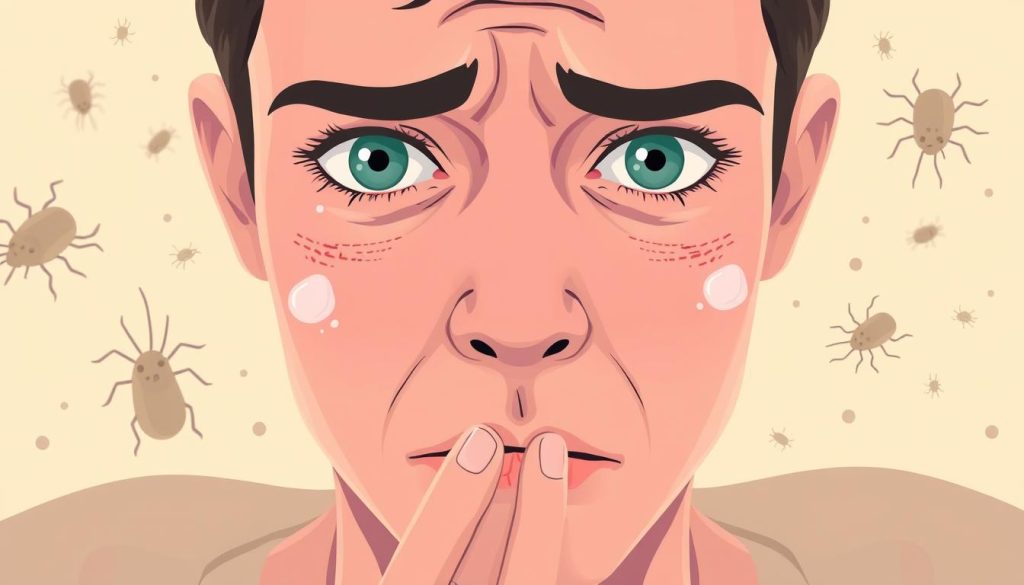
Understanding these symptoms helps find ways to cope. It lets people make their homes safer from dust mites. Knowing about dust mite allergy identification helps patients and their families. It helps them make homes that are less dusty.
Common Confusions: Allergies vs. Common Cold
It’s important to know the difference between allergy symptoms and cold symptoms. This helps us get the right treatment. Allergies and the common cold have unique signs that help us tell them apart.
Distinct Features of Dust Mite Allergy Symptoms
People with dust mite allergies often have long-lasting symptoms. They might sneeze, have a runny or itchy nose, and red, itchy eyes. Unlike colds, they usually don’t have a fever.
How to Differentiate Allergies from Colds
To tell allergies from colds, look at how long symptoms last and when they start. Allergy symptoms can last as long as you’re exposed to the allergen. Cold symptoms, on the other hand, usually go away in one to two weeks and may include body aches and a fever.
- Immediate vs. Delayed Reactions: Allergic reactions often happen right after you’re exposed to the allergen, like dust mites. Cold symptoms can take a few days to show up.
- No Fever: A key sign is no fever in allergy sufferers, unlike those with the common cold.
- Repetition and Pattern: Getting symptoms at the same time every year might mean you have allergies, not a cold.
Knowing these signs helps you figure out what you have faster. It can lead to quicker relief, whether it’s medicine, changing your lifestyle, or avoiding allergens.
Dust Mite Allergic Reactions: The Body’s Response
Dust mites are a common problem in homes. It’s important to know how they cause allergic reactions. These tiny creatures are strong allergens, especially in our homes. The body’s reaction to them can explain why some people react more strongly.
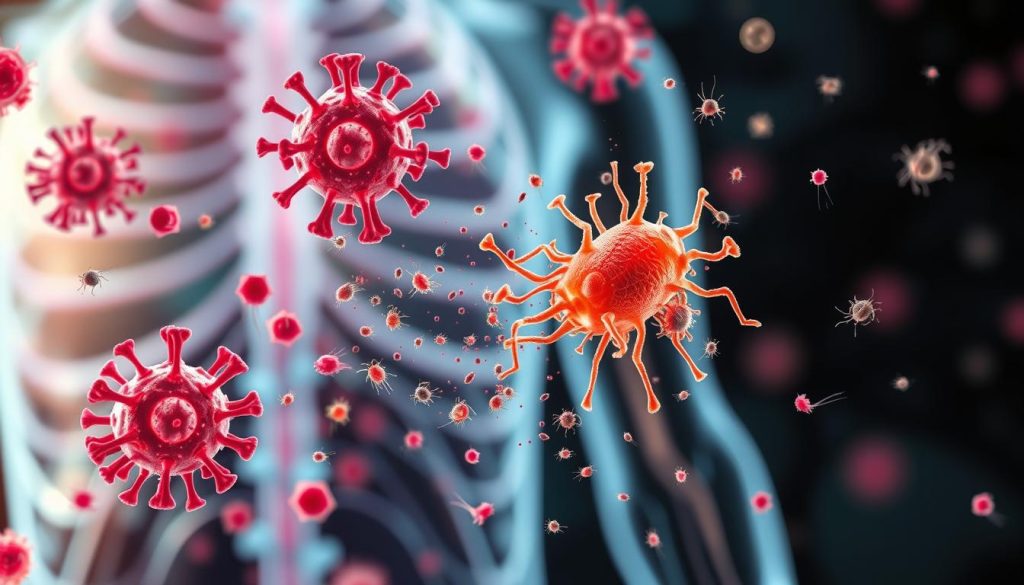
An immune system response to dust mites is like a mistake. The body sees dust mite debris as a threat. This leads to an overreaction, with the body making more antibodies to fight it.
Immune System and Allergens
The fight between the immune system and allergens is complex. When first exposed to dust mites, the body makes antibodies. These antibodies remember the allergen. Later, when they meet the allergen again, they release histamines, causing symptoms.
For more information, check out this detailed explanation on dust mite allergies.
Why Some Individuals are More Affected
Genetics play a big role in allergen sensitivity. If your family has allergies, you’re more likely to have them too. Also, being around dust mites a lot can make you more sensitive. This is why some people react more than others.
| Factor | Influence on Allergic Reaction |
|---|---|
| Genetic Makeup | Strongly influences immune system reactivity |
| Environmental Exposure | Increased exposure heightens sensitivity |
| Age at First Exposure | Earlier exposure can lead to heightened sensitivity |
Managing Dust Mite Allergies at Home
Dust mite allergy management begins with reducing allergen exposure at home. This includes your bedroom and living room. We’ll give you tips to make your home a healthier place to breathe.
- Vacuum regularly with a HEPA filter to catch dust mites and their waste.
- Use allergen-proof covers on your mattress, pillows, and box springs to keep dust mites out.
- Wash your bedding in hot water once a week to kill dust mites.
- Keep humidity below 50% to stop dust mites from living, using dehumidifiers if needed.
- Choose hard floors over carpets to reduce dust mite habitats.
Here are more tips to reduce allergen exposure:
- Regularly clean curtains and upholstered furniture.
- Use air purifiers to catch dust and other allergens in the air.
- Avoid heavy drapes and choose washable window treatments.
- Keep pets out of your bedroom to avoid their dander, which can make dust mite allergies worse.
- Reduce clutter to cut down on dust.
| Cleaning Frequency | Object | Benefit |
|---|---|---|
| Daily | Floors & Surfaces | Reduces potential allergens build-up |
| Weekly | Beddings and Curtains | Kills dust mites |
| Monthly | Upholstery and Carpets | Maintains cleanliness, lowers mite populations |
| Biweekly | Vents & Filters | Ensures cleaner, allergen-free air circulation |
By following these steps, you can make your home safer and healthier. This will help manage dust mite allergies and improve your life by reducing allergen exposure.
Symptoms of Dust Mite Allergy Across Different Age Groups
It’s important to know how dust mite allergies show up in different ages. This helps us manage them better and live better lives. Understanding age-related allergy differences is key to making treatments that fit each age group.
Recognizing Symptoms in Children
Young kids might not say they’re uncomfortable. Look for signs like sneezing a lot, itchy eyes, and a runny nose. Also, if a child is fussy or can’t sleep well because of their nose, it’s a sign.
Adult-Onset Dust Mite Allergies: Are They Different?
Adults with dust mite allergies might show different symptoms. They might have sinus pain, breathing problems, or even skin issues like eczema. It’s harder for adults to figure out they have an allergy because it can look like other health problems.

| Age Group | Common Symptoms | Unique Challenges |
|---|---|---|
| Children | Sneezing, runny nose, itchy eyes | Communication barriers; symptoms often mistaken for common cold |
| Adults | Sinus pressure, asthma, skin reactions | Overlap with other health conditions; Delay in seeking treatment |
Dust Mite Allergy Triggers
Understanding the different allergy triggers is key for those with dust mite allergies. Knowing these factors helps manage and lessen allergy symptoms.
Environmental Factors Contributing to Allergy Flare-Ups
Environmental allergens are everywhere, but knowing what triggers them helps. Humidity and temperature are important for dust mites. High humidity means more dust mites, making humid places harder for allergy sufferers.
Keeping an eye on the environment can help manage allergies.
Indoor Activities That Can Aggravate Symptoms
Indoor allergens come from daily tasks like cleaning and taking care of bedding. Sweeping or vacuuming can make dust mite particles airborne, worsening symptoms. Using allergen-proof covers and wet cleaning can help.
Dealing with dust mite allergies needs a plan that covers both outside and inside factors. By controlling these elements, people can see a big drop in symptoms. This improves their life quality a lot.
Seasonal Variations in Dust Mite Allergy Symptoms
As seasons change, dust mites grow more, affecting those with allergies. Knowing about dust mite allergies seasonality helps manage symptoms better. It’s important to see how allergies and weather changes are connected.

Dust mites love warm, humid places, making spring and summer hard for allergy sufferers. The warm weather and high humidity in these months mean more dust mites. In winter, cold might slow dust mites, but indoor heat makes places like beds and carpets perfect for them.
- Spring: Increased humidity and temperature facilitate the growth of dust mite populations.
- Summer: Continuously high levels of humidity and warmth can sustain peak dust mite populations, exacerbating allergy symptoms.
- Fall: Gradual decrease in temperature might reduce dust mites, but fallen leaves can create humid microenvironments, ideal for mite survival.
- Winter: Reduced outdoor temperatures may lower dust mite activity, however, indoor heating can negate this effect.
Knowing these patterns helps people get ready for allergy spikes in different seasons. Simple steps like using dehumidifiers and keeping places clean and dry can help. Seeing the link between allergies and weather changes helps allergy sufferers plan for each season.
Navigating Through Dust Mite Allergy Relief Options
Finding good dust mite allergy relief can be tough. But knowing what treatments are out there can help a lot. It can make living with this allergy easier.
Over-the-Counter Remedies
For quick help, over-the-counter (OTC) allergy meds work well. They include antihistamines, decongestants, and nasal sprays. These help with stuffy noses, sneezing, and itchiness from dust mites.
Alternative and Natural Relief Methods
Some people also try natural ways to fight their allergy symptoms. Using HEPA filters and keeping things clean can really help. It’s all about reducing dust.
To see how well OTC and natural remedies work, here’s a comparison:
| Method | Description | Benefits | Considerations |
|---|---|---|---|
| OTC Medications | Includes antihistamines and nasal sprays | Quick symptom relief | Possible side effects like drowsiness |
| Natural Methods | Utilizes HEPA filters and regular cleaning | Long-term allergen reduction | Requires consistent effort and maintenance |
Choosing the best dust mite allergy relief plan often means mixing OTC allergy medication and natural allergy remedies. This combo can really help fight off dust mite symptoms.
Professional Dust Mite Allergy Treatment
If dust mite allergy symptoms won’t go away, it’s time to see an allergy specialist. They can help ease your symptoms and find the cause of your allergies.
When to See an Allergist
See an allergist if dust mite allergy symptoms keep coming back. Or if they really affect your daily life. A professional test can help find the right treatment for you.
Immunotherapy and Its Effectiveness
Immunotherapy treatments help your body get used to dust mites. It’s shown to lessen symptoms and might even cure them for good. Working with an allergist makes it even more effective.
For more information, check out this article on the Mayo Clinic website.

Long-Term Strategies for Dust Mite Allergy Prevention
Adding allergy prevention strategies to your daily routine can help lessen dust mite allergy symptoms. Knowing and using the right steps can make your home healthier. This is especially true for minimizing allergen exposure.
Preventive Measures for Dust Mite Control
To control dust mites, keep your home clean and adjust its environment. Vacuuming with HEPA filters and washing bed sheets in hot water weekly are key. Also, use allergen-proof mattress and pillow covers to block dust mites. Keeping humidity levels below 50% also helps stop dust mites from growing.
Lifestyle Changes to Minimize Exposure
Changing your lifestyle can also help fight dust mite allergies. Choose easy-to-clean furniture and flooring like wood or tile instead of carpet. Decluttering also helps reduce dust, which is good for minimizing allergen exposure.
| Strategy | Description | Frequency |
|---|---|---|
| Use of allergen-proof covers | Encase mattresses and pillows to trap dust mites | Consistently |
| Hot water washing | Wash beddings at 55°C (131°F) or higher to kill dust mites | Weekly |
| HEPA filtration | Use vacuum cleaners with HEPA filters to capture ultrafine particles | Daily or as needed |
| Dehumidify | Maintain humidity levels at or below 50% | Daily monitoring |
By following these allergy prevention strategies and lifestyle changes, you can make your home safer. This can greatly reduce dust mite allergy symptoms, improving your life quality.
Complications Arising from Untreated Dust Mite Allergies
Many people think of allergies as a minor issue. But, untreated allergies can lead to serious health problems. For those allergic to dust mites, it’s important to understand and tackle these allergies. Without proper action, exposure to dust mite allergens can cause long-lasting and severe respiratory issues, affecting overall health.
Impact on Respiratory Health
Unmanaged dust mite allergies can cause serious respiratory problems. It can make asthma worse, leading to more severe attacks. Symptoms like coughing, wheezing, and shortness of breath can become a daily struggle.
This can make it hard to live an active and healthy life. Untreated allergies can also cause sinus infections. The body’s fight against allergens can inflame sinus tissues and block drainage, leading to pain and discomfort.
Quality of Life and Allergy Complications
Living with allergies affects more than just physical health. Untreated allergies can disrupt sleep, causing fatigue and decreased focus during the day. This “allergy fog” can hurt school performance, work productivity, and personal relationships.
Managing allergies requires constant attention, which can be mentally exhausting. The social and economic costs of chronic allergy management are significant. Getting a proper diagnosis, starting treatment early, and using effective management strategies are key to avoiding these issues and improving long-term health.
FAQ
Q: What are some common dust mite allergy symptoms?
A: Symptoms include sneezing, a runny or stuffy nose, and itchy eyes. You might also feel sinus pressure. In some cases, it can cause asthma-like symptoms like wheezing and trouble breathing.
Q: Can dust mite allergies be managed at home?
A: Yes, you can manage them at home. Regular cleaning and using dust-mite-proof covers for bedding help. Also, keep humidity low and use air purifiers.
Q: What are dust mites and why do they cause allergies?
A: Dust mites are tiny creatures that eat human skin flakes. Their waste and body parts have proteins that cause allergic reactions when inhaled or touch the skin.
Q: How can I tell if I have a dust mite allergy or just a common cold?
A: Allergy symptoms last as long as you’re exposed to the allergens. Cold symptoms usually go away in a week or ten days. Allergies often make your eyes itch and don’t cause fever.
Q: What triggers dust mite allergic reactions?
A: Actions like vacuuming or dusting can release dust mite particles into the air. A warm, humid environment also encourages dust mites to grow.
Q: Are dust mite allergy symptoms different in children compared to adults?
A: Symptoms are similar but harder to spot in kids. For example, a child might always sniffle or rub their nose, known as the “allergic salute.”
Q: How do seasonal changes affect dust mite allergies?
A: Dust mite numbers go up in warm, humid weather and go down in cold. But, indoor heating in winter can make dust mites survive all year, causing symptoms for some people.
Q: What over-the-counter remedies are available for dust mite allergy relief?
A: You can try antihistamines, decongestants, and nasal corticosteroids. They help with a runny nose, sneezing, and nasal congestion.
Q: When should someone with a dust mite allergy consult an allergist?
A: See an allergist if symptoms are severe, last a long time, or affect your daily life or sleep. Also, if over-the-counter meds don’t work.
Q: What are some preventive measures for dust mite control?
A: To control dust mites, encase mattresses and pillows in dust-proof covers. Wash bedding in hot water weekly. Keep humidity below 50% and remove carpeting or heavy drapes.
Q: What complications can arise from untreated dust mite allergies?
A: Untreated allergies can cause chronic sinusitis, ear infections, or make asthma worse. This can severely impact your health and quality of life.












